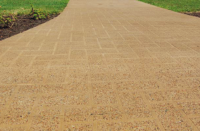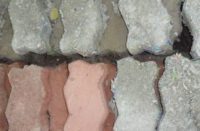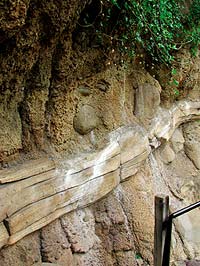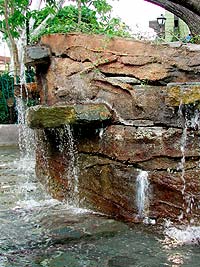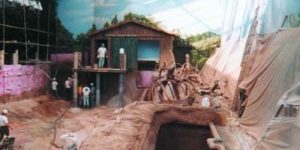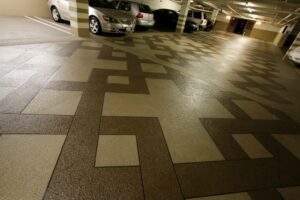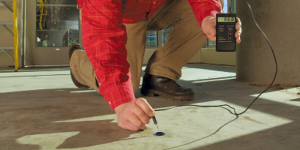Moisture intrusion is one of concrete’s biggest enemies. When moisture creeps in, so can cracks, discoloration, delamination or even bigger problems. Concrete Decor™ presented three common moisture problems to experts in the decorative concrete industry and asked them to offer solutions. Here’s what they had to say:
 Your customer calls six months after the job is complete and complains about white stuff on the concrete (… and it’s not snowing).
Your customer calls six months after the job is complete and complains about white stuff on the concrete (… and it’s not snowing).
Terry Tomlinson, technical director for White Mountain Products, had a few questions about the above scenario: Has a sealer been used? If so, was it water-based or solvent-based? And most important, why did the “white stuff” appear?
That “white stuff,” or efflorescence, shows up when moisture has moved through the slab, carrying minerals with it. A white residue is left behind when the water evaporates.
One way to gather more information about the problem is to make a $10 investment and purchase a calcium chloride test kit that will determine excess moisture or moisture vapor problems. The dry calcium chloride collects water if moisture is present. The amount of weight the calcium chloride gains indicates how much moisture is coming through, Tomlinson said.
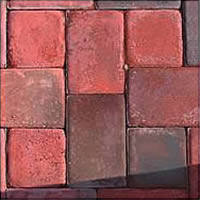 If the job has not been sealed, Tomlinson suggested a simple cleaning with a broom, following up with an efflorescence remover if needed. Applying a solvent-based acrylic sealer will also make the efflorescence disappear.
If the job has not been sealed, Tomlinson suggested a simple cleaning with a broom, following up with an efflorescence remover if needed. Applying a solvent-based acrylic sealer will also make the efflorescence disappear.
“What’s happening is the salts dissolve in the sealer, and in the dissolved state they’re invisible,” he said. “When the sealer dries, there’s no change. The salts remain dissolved in the resin.” Keep in mind, though, that the high-gloss finish will give the project a whole new look.
If the job is already sealed with a solvent-based acrylic, Tomlinson suggests correcting the problem by reliquifying the sealer with a solvent, allowing it to repenetrate the slab, and then touching up the sealer with a light coat. If a water-based sealer was used, it must be removed chemically.
Of course, moisture can also be a problem in a newly installed slab. Bart Sacco, owner of Concrete Texturing Tools & Supply, said moisture can get trapped between the slab and the sealer membrane if the sealer is applied before the concrete has cured completely. High-gloss, solvent-based sealers can give a project a high-end look, but if they’re not breathable, moisture problems can result.
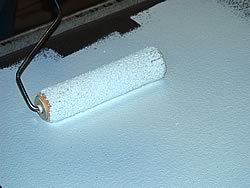 If concrete is poured on Tuesday and pressure washed, dried and sealed on Thursday, that’s not nearly enough time for all the moisture to come out of the slab, Sacco said. If the concrete has a white hazy look, it’s likely that moisture is fogging between the solvent-based sealer and the slab.
If concrete is poured on Tuesday and pressure washed, dried and sealed on Thursday, that’s not nearly enough time for all the moisture to come out of the slab, Sacco said. If the concrete has a white hazy look, it’s likely that moisture is fogging between the solvent-based sealer and the slab.
He suggested first allowing the concrete to naturally aspirate the moisture before taking any corrective measures. “Let it do its thing, and then come back in a week or two and give it a bath with a solvent, a liberal coating,” Sacco said. “I would use xylene. Spray it on and let it emulsify. It lets moisture out when the solvent burns off into the atmosphere. Then put another sealer on top of it.”
Do a spot test first. If it dries crystal clear, go to work on the rest of the slab, he said.
In the case of chalky-looking efflorescence on a slab, Sacco agreed with Tomlinson, saying that it would be a good idea to strip the sealer, and then clean the surface with an efflorescence remover or TSP. Then allow it to dry thoroughly and reseal.
The most important thing to do is solve the moisture problem, not just cover up the evidence, Tomlinson said. “If you have poorly drained soil, then you have to correct the drainage problem.”
If the concrete was placed over damp soil, then nothing needs to be done except giving it time to dry out and evaporate through the slab. In some cases, he says, that can take as long as a year.
“It’s a hard thing to tell people they have to be patient, but the reality is if they’re not, the problems just reoccur,” he said.
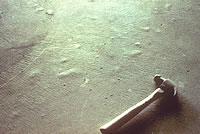 You want to pour an overlay and you can see that the slab has moisture problems. What is the best way to take care of the moisture and ensure that your application will be successful?
You want to pour an overlay and you can see that the slab has moisture problems. What is the best way to take care of the moisture and ensure that your application will be successful?
Overlays have long been used to repair cracks and other damage in existing concrete surfaces, while creating a fresh look. The general rule of thumb, however, is that the overlay is only as good as the substrate.
Solve the moisture problem first, the experts say, because the key to success is a good bond to the existing concrete surface. The slab must be dry, structurally sound, and free of sealers, coatings, paints, oil, dirt or any other contaminants that will break the bond.
Bob Ware, owner of the Decorative Concrete Store in Cincinnati, Ohio, said it’s important to determine if the moisture is a one-time problem or a continuing issue.
Ware said he would first shotblast the concrete to remove sealers and other contaminants. He then likes to seal the surface with an Ardex or Mapei product, particularly Mapei’s Planiseal 88, which he applies in two thin layers. “It’s a moisture-proof material that doesn’t allow moisture to penetrate or come up from the bottom,” he said. For example, if the contractor is planning to apply a quarter-inch overlay material and then stain it, “this assures the client that the material won’t debond itself and come up off the floor.”
But having said that, he added that he might refuse a repair project if there’s moisture on the floor. If he did take the project on, he’d be hesitant to give it a lengthy warranty, as there are so many unknowns. “There are a lot of things to consider if there’s water under the concrete floor.”
Peter Golter, product manager for Mapei Corp.’s concrete restoration systems, suggested conducting three tests to clearly understand the problem, which is typically related to moisture vapor transmission.
When concrete surfaces are blocked off with tight or non-porous toppings, the moisture builds up in the concrete until it is completely saturated, he said. The un-reacted cement in the concrete — called free-lime — is soluble in water. This salt water attracts fresh water, creating osmotic pressure, which can exceed 200 psi. “If the concrete’s tensile capacity is less than the osmotic pressure, the mode of failure can be a rupture in the concrete substrate,” he said.
What to do?
Golter said Mapei has developed a new product, Planiseal MRB (Moisture Reduction Barrier), that can bring a high-moisture slab back into compliance for decorative toppings, including epoxy and urethane topcoats. Planiseal MRB will take up to 12 pounds/1,000 square feel/24 hours of moisture vapor transmission, or up to four times the safe limit, he said.
He recommends prepping the surface by shotblasting or diamond cut grinding to remove contaminants and open up concrete pores. Make sure the surface is free of dust. Apply the Planiseal MRB according to Mapei’s instructions and cure for 16 to 24 hours. “The decorative system can be applied on top of the Planiseal MRB using an epoxy-based primer followed by the topping,” he said. “Then stain the surface, wash it and seal it as you would a typical system.”
Another company, Applied Concrete Technology, offers the Protecrete Floor Saver System, which provides permanent waterproofing for portland cement concrete subfloors. Part One of the system is spayed onto the bare concrete slab. It penetrates deep into the concrete, forming a permanent gel-like barrier against moisture, said co-owner David Johnson. Even under the severe conditions like hydrostatic pressure, moisture will not enter the dense concrete slab. Part Two is applied with a roller or squeegee and creates a tough, but breathable membrane with excellent bonding properties.
The Mix Water Conditioner is a chemical added to the mix water before coming into contact with the portland cement, creating tight, high-quality concrete at a reasonable cost, Johnson said. This product hydrates more of the cement in the mix for the overlay, making it denser and less permeable. Johnson said his company’s Web site, www.Protecrete.com, contains answers to many questions about moisture problems.
Customer No. 3 has a pond with faux rock features that are in constant contact with water. He’s having problems with discoloration and spalling. How can you correct the situation?
Dave Sletten, director of national sales at Custom Rock, said minerals in the water that build up over time could cause surface discoloration. Mineral deposits will wear off with periodic cleaning, but won’t go away permanently. Discoloration could also be caused by efflorescence. “If it’s an existing surface, the best solution would be a sand blast to get back to bare concrete,” he said. “Get all the paints and stains off and go with a cementitious product like Thoroseal that can be painted over the surface without changing the surface texture, and repaint over that.”
Spalling can occur when there is a poor bond between the texture coat and the rough coat. When moisture is drawn into the rock, the water pushes the texture coat off. “The only thing to do with that is just to patch those areas. Get the loose materials off the surface, get a good bonding agent to reapply the texture coat, make sure it’s well-cured and then do sealer, paint, etc.,” Sletten said.
Johnson, of Applied Concrete Technology, said he’s seen discoloration come from limestone that’s either part of the cement or placed around the base of the water feature. The company’s Repeller is being used to stop fading on painted concrete surfaces. It also prevents the concrete or limestone from discoloring or leaching into the water and killing the fish in the pond, Johnson said. The company’s Densifier — a spray-on, permanent waterproofer — will stop spalling and efflorescence.
David Long, of the Lakeland Company, said poor application methods and low-quality materials usually cause moisture problems on water features. The first thing he would do is to check out the damage. “The biggest thing is a thorough inspection, and a good knowledge of weight load and footing applications.”
Just as a painting contractor wouldn’t paint over wet dry wall, decorative concrete contractors should make sure the feature is worth saving. “In some instances, you’re better off completely removing the product and starting over,” he said.
If the faux rocks are hand-plastered over rebar and a wire cage, the feature could be constantly crumbling. Contractors can shotcrete over it and then carve the rocks.
“You have to make a judgment,” Long said. “Can I warranty this repair?” The client is searching for someone to eliminate the headaches from the last “bad guy” who did a poor job, he says. “If we can’t come up with a good long-term solution, we’re the new bad guy.”

